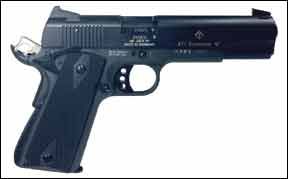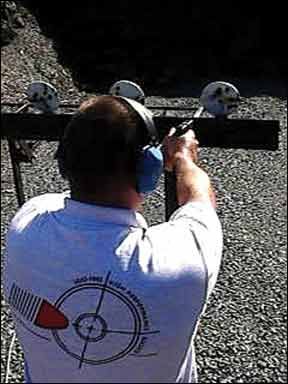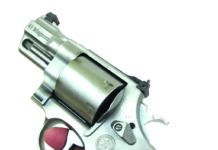Re: “1911 Replica Rimfires: GSG, Umarex
and Browning Compete,” May 2012
I was surprised when I read about the GSG 1911. Mine has become one of my favorite handguns because it has never malfunctioned. It also seems to prefer economy ammo, particularly Winchester Wildcat. Mine came from Acme Gun Store in Seymour, Indiana, for less than $350 and will outshoot several guns that cost a lot more. Also, it is already threaded for a suppressor. I hope your sample comes back and functions as well as mine does. I’m watching for your follow-up on this gun. Your magazine is the only one I subscribe to, and I share it every month with my “coffee-drinking” friends. The management at McDonalds would be surprised if they knew what handguns were examined in their dining room. Keep up the good work on a great magazine.
—Jim Jones
Greensburg, Indiana

I purchased the ATI/GSG 1911 in March and had similar results to your test. The ammunition appeared to be too low when the shell was chambered and would jam before entering the chamber. I ordered two extra magazines and the result was the same with them. So far the only ammunition that will work consistently in my gun is the CCI Stinger 32-grain. The Stinger has a rounder bullet and will feed flawlessly. None of the other brands I tried worked. I got one or two jams per magazine of shells. I really like the pistol when it is working. It is accurate and has a feel to it that I like. What results did you have when you returned the gun to the manufacturer for repair? I have not contacted them or returned the gun. I was interested in seeing if sending it back was successful.
— Richard C. Monteith
Batesville, MS
We sent the GSG back for repair and three days later, it was back. That’s a day shipping there, a day in the factory, and a day back. But we haven’t had a chance to shoot it yet. Will advise. — Todd Woodard
I just thought I should write and respond to your test of the three Model 1911 22 LRs in the May 2012 issue of Gun Tests. This included the GSG, Browning, and Umarex (Colt/Walther). I received the magazine with the article the same day, but after I had already purchased a GSG 1911 22 LR for myself. I was disappointed to read the report that day, before I even had the opportunity to fire my gun. Since then, I have had the pleasure to fire the gun and found that I did not have the problems you observed. With the exception of an issue with the Winchester Wildcat 40-grain lead roundnose, which only had a feed problem when eight and nine rounds remained in the magazine. The first round would fire (#10), extract and eject, but would not feed the next round when rounds #8 and #9 remained in the magazine. Once there were only seven rounds in the magazine, the gun worked smoothly and flawlessly. Other rounds fired worked smoothly and flawlessly with a full (10-round) magazine from the start with no feeding, firing, extracting or ejecting issues. Other rounds fired included Winchester 22 LR RN plated and 22 LR 37-grain HP Lubaloy plated; Federal 22 LR RN plated (1240 FPS), and 22 LR HP Plated (1430 FPS); CCI Stinger 22 LR Hyper Velocity HP Plated, and PMC Zapper 22 LR High Velocity 38-grain HP Plated.
Everything else you indicated about the gun I found in mine. The fit and finish were excellent, trigger pull was crisp, clean and consistent, wonderful sights, very nice wood grips, and the feel of a full-sized 1911. At 25 feet from the target, the point of impact was only slightly above the point of aim. My gun only came with one magazine, but the two additional GSG mags I purchased worked great and they are all steel.
Having shot a Ruger Mark II with a 4-inch bull barrel for many years, I am even more excited about how easy this gun is to strip, clean, and reassemble compared to the Ruger. In the end, both my buddy, who also fired the gun, and I believe it is one of the easiest and best shooting 22 semi-autos we have ever fired. I look forward to many years of enjoyment with this gun.
—Bob Ries
St. Paul, Minnesota
Re: “Frangible Ammunition Testing: We Give
Nine Loads a Fair Shot,” July 2012
I really liked your test on frangible ammo. I was concerned about what would happen if a round gets away during a gunfight and misses the target completely, as opposed to overpenetration through a target. This could be very important to condo/apartment dwellers or anyone with a lot of other people in their home or office. My son and I did a simple (and crude) test. We shot a 9mm Air Freedom round through two layers of drywall spaced 3.5 inches apart and then into a dry phone book 3.5 inches behind that. I was surprised to see that the 9mm Air Freedom round broke up in the drywall, but still mangled the book pretty well.
But it was obvious that it was completely fragmented in the two layers and was spreading rapidly. Another wall a few feet away would probably not have been penetrated. Shooting a round into a phone book without any barrier resulted in a nasty crater about 2.5 inches deep. This is a pretty crude test, but it does address an important issue: How do these home-defense bullets behave if one gets away from you in a gunfight? It would be interesting to see how the various home-defense rounds actually behave, and how deadly they remain, if they miss the target and hit a wall. —Tom
That is an important question, so important that we have had Bob Campbell working on the answer for nearly a year. We will publish the results of his findings within a few months. While we cannot test every round available, he does plan to shoot a lot of popular rounds through a range of stuff. — tw
I recently wrote you a letter reminding you of your promise to do a piece on frangible self-defense ammo, and, lo and behold, an article on frangible ammo appeared. Thank you, it was a great article.
But I was a little disappointed that you only focused on 9mm and 45 ACP ammo. Many of us with carry permits rely on the 380 ACP pistol for our carry weapon, and we would love to know how effective those rounds are. For example, would the Glaser Safety Slug Silver, which you gave a great rating, protect us if loaded in a Kel-Tec P3-AT, Ruger LCP, or Sig Sauer P238? I use the Glaser Silver mixed with Speer Gold Dot hollowpoints all the time in my Kel-Tec P3-AT. Could you possibly do a follow up on frangible self defense ammo effectiveness in 380 pistols such as these? Thanks for a great publication for us gun enthusiasts.
— Don J

I forwarded your idea to Bob Campbell for development. — tw
Re: “Inexpensive Red Dot Sights—BSA, NcStar,
Tasco, & Bushnell,” June 2012
Too bad you didn’t test the Leapers SCP-RD40RGW. I would have liked to have seen how that one ranks with the others. I think I paid a little less than $50 for it. Once dialed in, I can repeatedly hit the bull’s-eye with my AR-15. The true test is to calibrate, remove and store for a few months, and then reinstall and go shooting. I have not had to calibrate the Leapers more than once. I treat it with a little more respect than you treated yours with. I have never dropped it from 4 feet.
Good article, though. The real ringer would be the EOtech for $400 — not the Bushnell for $100. You pay extra for battery life. The trade-off is a baggy full of cheap batteries and a good inexpensive red dot or one battery and the EOtech. But if the SHTF for more than a few months, we’ll all be out of batteries and back to our flip-ups. Better dial those in, too.
The scary part is that most of the affordable red dots are made in China. You didn’t mention this in the article. I think that is a big omission.— RG, California
I think the tests on inexpensive red-dots in the July issue missed a very important point — the optical quality of the dot itself. Many buyers of red-dot sights consider the sharpness and roundness of the dot to be very important. Some dots are not round, are not crisp and sharp in appearance, and have flare that is very distracting. I would consider comments on these characteristics to be an important part of your testing protocol. Also, it would have been interesting to hear your thoughts on what justifies the higher prices of the expensive sights.
— Bart Frechem
All red-dot scopes have a lens that is spherical in shape as the objective lens. Unlike a regular rifle scope, the lens in a red dot is used off axis and as a reflector for the LED. We mentioned this in the story. Using a lens off axis can create a smeared dot, the smearing coming from aberrations. This usually occurs in inexpensive red dots where manufacturing tolerances are less stringent.
We did not find smearing, or as you state a “flare,” in the scopes tested, and we noted at various intensities the dot was a crisp point or fuzzy. Each shooter’s eyes are different, and if we did find issues we would have made note of it. We don’t anticipate anyone jumping out of helicopters with these red dots on ARs, but for plinking with rimfire calibers they suit the purpose. How suited these red dots for centerfire calibers is perhaps another story idea. Thanks for your comments. —Robert Sadowski
Re: “Dangerous-Game 357 Magnums: Cor-Bon,
Grizzly Clear Winners,” May 2012
Why did you review Buffalo Bore 158-grain ammo and say it was the best of the non-180-grain ammos available, but that it was not as good as Grizzly or Cor-Bon 180- grain ammo, for bear defense, when Buffalo Bore has a 180-grain 357 Magnum load available for bear defense? You could have compared apples to apples (180 grain to 180 grain) rather than apples to oranges (180 grain to 158 grain). I emailed Tim Sundles at Buffalo Bore and he had the same question.
Adding to your “Dangerous-Game” article, Tim has a very interesting column on “Stopping bears with handgun or rifle cartridges,” which is one of the technical articles at his online sales website. I recommend the column as Tim has more bear knowledge than most of us and certainly more than I do. I have no financial or other connection to Buffalo Bore except that I buy and use their ammo for concealed urban and rural carry (I carry 24/7). Fly Navy.
—Peter M. Margolius, LCDR, JAGC, USN, ret.
On the question of the Buffalo Bore hard-cast bullet, I am certain it would have performed at least as well as the competing cast bullet loads. However, this test was as much of different types of ammo as of specific loads. The Buffalo Bore 158-grain JHP is probably the single load that is best suited for all-round use that uses a JHP bullet. We tested light, medium, and heavy bullet loads. Naturally, the reader would find Buffalo Bore’s 180-grain cast bullet a great performer as well. — Bob Campbell
Value Guide Recommendations
In the July issue, you published your a Value Guide to 9mm Carry Pistols. It is nice to have a quick-reference overall guide; however, I am not sure that tests going back to February 2009 are useful with all the changes going on in the pistol business. Take Glock, for example. You gave the G19 (8/2010) a rating of A-; however, Glock is now selling the Gen-4 editions. I am interested in purchasing a Gen-4 Glock 17 or 19. Do you have any updates on either of these Glocks? I am looking for a gun for home protection as well as carry. Would the G17 be a disadvantage in trying to carry concealed over the G19? — Richard
We are always looking for value, and many super, but older, guns become less expensive over time. Newer is not always better, we’ve found. We are constantly testing new guns, so we’ll get around to the newest Glocks in due time. — tw
45-70 Govt. — Where’s the Love?
Various gun magazine subscriptions have come and gone at my house over the years, but Gun Tests has been a mainstay since I first discovered it several years ago. I look forward to every new issue, and I appreciate the time and effort that shows in each of them. That said, I have a suggestion. How about a write-up or two on the venerable 45-70 Govt. cartridge? With current manufacturers such as Marlin, Ruger, Browning, CVA, Rossi, H&R, Henry, Chiappa, and NEF, surely a sample of firearms could be put together with various types of ammo. So, how ‘bout it gentlemen?
— Scott Butcher, Georgia
Scott, I forwarded your list to Ray Ordorica for story development. — tw






























